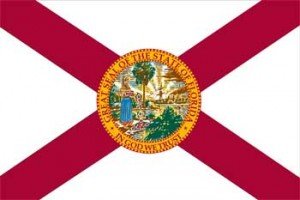Florida Emergency Vehicle Light State Statutes
 Florida emergency vehicle light laws serve two main purposes. Determining which vehicles can display these lights and under what circumstances they are displayed have the design of protecting motorists from dangerous criminals impersonating police or other emergency personnel.
Florida emergency vehicle light laws serve two main purposes. Determining which vehicles can display these lights and under what circumstances they are displayed have the design of protecting motorists from dangerous criminals impersonating police or other emergency personnel.
These laws for emergency lights also aid emergency and other vehicles in performing important duties. To that end, vehicles in Florida that properly display lights may have certain privileges to speed, run red lights or use other lanes. The lights also warn motorists and pedestrians to stay clear and move over so that these emergency vehicles can perform life-saving and other important task for the public.
Below, we highlight the main categories of emergency vehicles and the lights that are permitted. Most of these laws come from Section 316.2397 of the Florida Statutes.
Police Lights
Florida Statutes Section 316.2397(2) allows blue lights on vehicles of police departments, the Florida Highway Patrol, and Sheriff's Offices. Where an emergency arises, a vehicle driven by probation or parole offices working for the Florida Department of Corrections or a local corrections agency may have blue lights. Anyone else using flashing or strobe blue lights on a vehicle generally violates Florida law.
Under Section 843.081, it is generally against the law for any person in a non-government-owned vehicle to use a blue rotating or flashing light unless the person is a police officer, sheriff or a deputy sheriff, or a Florida state trooper. Businesses licensed by the State of Florida to sell or repair law enforcement equipment, along with their sales or repair personnel and other employees, may display the flashing blue lights while engaged in their work for the business. (Section 843.081(3).)
According to the Florida Attorney General, the fact that the blue lights are not actually used doesn't affect who is prohibited from having them.
Section 33-602.701 of the Florida Regulations further expands upon use of blue police lights. These rules permit facilities to have up to three primary and secondary canine unit vehicles with blue lights. Facilities may have blue lights for up to two vehicles designated to trail external EMS transport vehicles.
Vehicles using only blue lights must follow all the traffic laws including those for speed and obey stop lights and signs. The drivers may sound the sirens along with using blue lights in emergencies, such as finding escapees, or providing armed escort to emergency vehicles transporting inmates.
Fire Truck Lights
Under Florida Statutes Section 316.2397(3), Fire department and fire patrol vehicles may exhibit red lights in emergencies. These include vehicles from municipal or government fire departments and those of volunteer firefighters under the conditions set forth in Section 316.2398 of the Florida Statutes.
Volunteer Fire Fighter Lights
Red lights are permitted by sections 316.2397(3) and 316.2398(1) in the private vehicles of active volunteer firefighters. However, there are limits and conditions:
- The volunteer firefighter must actually be traveling to the fire station in connection with going to the incident at the time of use.
- The operator may display up to two red warning signals.
- The firefighter must get the department chief's permission to use the red warning signals or any type of LED light bar. The driver must carry the permit while using the warning signals.
- The face of the siren lens must be free of any writing or inscription.
According to Section 316.2398(5), volunteer fire department members who use red lights in their vehicles in violation of Section 316.2398 face mandatory dismissal from their departments.
Ambulance Lights
Section 316.2397(3) also permits red lights for ambulances operated by local governments or by public service corporations run by private companies. As with volunteer firefighters, physicians or medical staff members of health care facilities licensed in Florida may equip their privately-owned vehicles with and operate from them red warning lights in emergency situations. (See Section 316.2398.)
Tow Truck Lights
Wreckers in Florida may use amber lights when they are towing vehicles or otherwise operating, under Section 316.2397(3). Hazards also present a reason for wreckers to activate the lights. In either case, the tow truck driver must get authorization, either through permission or direction, from a law enforcement officer or agency when driving to and from the place of operation or hazard.
Section 316.2397(3) mandates flashing or rotating amber lights when the tow truck operator recovers or loads Vehicles along roadsides. This requirement applies during the daylight hours as well as evening and nights.
Road Construction and Maintenance Vehicle Lights
Under Section 316.2397(5), construction vehicles are allowed to have white lights while they are operating and in hazards.
For road maintenance vehicles, subsection (4) allows amber lights when an operation. Where there is a hazard, those lights can be white, flashing or strobe. (Section 316.2397 x (5).)
Utility Vehicle Lights
 Florida law does not express leave permit flashing lights for utility vehicles. As such, these generally are not deemed emergency vehicles.
Florida law does not express leave permit flashing lights for utility vehicles. As such, these generally are not deemed emergency vehicles.
However, Florida Statutes Section 316.126 places motorists who approach utility trucks within the reach of the requirement to move over and slow down. Specifically, vehicles that come upon a utility truck must do the following:
- Get out of the land closest to the utility truck
- If the posted speed limit where the utility truck is operating is 25 miles per hour or more, the motorist may drive no more than 20 miles per hour under the speed limit. For example, if the speed limit normally rests at 35 miles per hour, the approaching driver must slow to 15 miles per hour or less.
- If the post speed limit stands at 20 miles per hour or less, slow the vehicle by at least five miles per hour less than the limit. As an example, where the posted limit is 15 miles per hour, the driver cannot go faster than 10 miles per hour when approaching a utility truck.
Utility vehicles performing tasks such as fixing power poles or power lines are to display any visual signal, such as flashing tail lights, to alert motorists of their presents.
Pilot Vehicle Lights
The trucks and cars that escort vehicles carrying mobile homes, cement, steel and other oversized buildings or building materials may display amber lights during their escorts. This permission is provided by section 316.2397(3).
Private Security Vehicle Lights
Private security vehicles include those that may patrol shopping centers, office complexes, apartment complexes, plants and other private properties. These are owned by non-governmental security firms and come within the ambient of Section 316.2397(3). Private security vehicles may also be employed in providing security to public property, such as courts or other governmental grounds and offices.
Permitted lights for these vehicles include green and amber, so long as either color does not exceed half of the lights displayed. Operators of these vehicles may display the lights while engaged in security functions on either the private or even public property.
Emergency vehicle lights warn motorists of the approach of police, fire, rescue and other responders to emergencies. Often, especially in the case of police, the blue lights may compel motorist to stop and await the officer. The Florida state emergency light statute is designed to ensure the safety of motorists from traffic collisions involving these vehicles or from impersonators seeking their own criminal designs.
For more information about what lights may be available to you, we suggest calling your State Highway Patrol office at: 850-617-2000
*Please note that these numbers are what we are currently able to find and the numbers may have changed since this listing.
Disclaimer: The emergency vehicle light state statute guide was created by Extreme Tactical Dynamics as a guide and reference. We make no claim to the accuracy or validity of this guide. This guide was written to the best of our knowledge and has been provided to our customers as a courtesy ONLY! The information in this guide is our interpretation of the law as we have read it. We cannot be held responsible for any errors as this is only our interpretation of the law and the laws are constantly changing. We cannot be held liable or responsible for any errors and recommend that our customers refer to their local authorities to confirm the particular statue that governs their use of emergency vehicle lights.
 Facebook
Twitter
Google+
Instagram
YouTube
Facebook
Twitter
Google+
Instagram
YouTube


